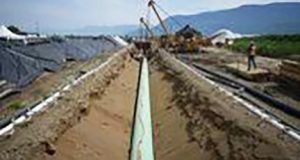By Sam Laskaris
Local Journalism Initiative Reporter
A report released earlier this week indicates it will be a couple of years before the Indigenous tourism sector in Ontario recovers to pre-pandemic levels.
The report, which was released on Tuesday, was commissioned by Indigenous Tourism Ontario (ITO), the provincial organization that supports the growth of the Indigenous tourism industry.
The 34-page report is titled Impact Assessment of COVID-19 on Ontario’s Indigenous Tourism Industry.
The report indicates the Indigenous tourism industry in Ontario will only partially recover in 2022 and that it will take until 2023 to reach (Gross Domestic Product) GDP and employment levels in 2019, the year before the pandemic began having significant impacts in Canada.
The report was prepared by MDB Insight, a company with various specialities including providing market research solutions and supporting tourism and economic development initiatives.
Kevin Eshkawkogan, ITO’s chief executive officer, said his organization had done its own projections on pandemic impacts after compiling data in March and April of 2020.
“We projected a loss of $330 million for the tourism industry and the GDP,” he said, adding ITO officials felt the pandemic would also result in the loss of about 4,000 jobs in the Indigenous tourism sector in the province. About 13,000 people were working in the Indigenous tourism sector in Ontario in 2019.
Eshkawgogan said it was beneficial to have a third party do its own research into the industry on a provincial level.
“They basically validated our projections,” he said. “They were pretty much bang on with the loss of jobs.”
The report also basically duplicated ITO’s projected losses. In 2019, the Indigenous tourism sector in Ontario contributed about $650 million to the GDP.
The report found the pandemic had forced a loss of about $332 million in GDP in 2020.
MDB Insight was brought on board in early 2021 to conduct its research and prepare a report.
Like ITO officials, Eshkawkogan said reps who prepared the report are unable to provide an accurate number of how many Indigenous tourism businesses in the province have closed their doors forever due to pandemic impacts.
“We don’t know how many are permanently closed or if they are temporarily closed,” he said. “They couldn’t get a hold of our members. That’s the issue now.”
Eshkawkogan said ITO officials do understand that some of those companies that were operating in the Indigenous tourism sector will not be returning.
“We know some business operators have moved on to other things,” he said.
Eshkawkogan added not all Indigenous tourism operators in the province have faced significant impacts during the pandemic.
“It really depends on the sector,” he said. “Restaurants took a kicking. They really got hurt. But some hotels did amazing. It really depends on the business.”
Eshkawkogan also said impacts in the industry varied from community to community. That’s because some First Nations shut down their communities during the pandemic for extended periods and would not allow visitors. Some continue to remain closed.
Other Indigenous communities, however, had some restrictions in place but some businesses were still able to welcome non-members in.
The ITO-commissioned report of how long recovery efforts will take paints a much rosier picture than what Keith Henry, the president and CEO of the Indigenous Tourism Association of Canada (ITAC) publicly shared a couple of months ago.
In September Henry said that information compiled from Destinations Canada and its partners suggested it would take until 2028, and possibly even 2030 before the Indigenous tourism industry would fully recover from pandemic impacts.
Eshkawkogan though is confident the recovery in Ontario will be much quicker than elsewhere in the country.
“In Ontario, from what we’re being told, we’re going to be ahead of the curve because of the work we’ve done,” he said.
Eshkawkogan said there are numerous Indigenous tourism operators in the southern part of the province that will greatly contribute to a faster recovery period.
“The southern Ontario markets are huge,” he said. “That particular market for the Indigenous tourism market is really, really good.”
Eshkawkogan also believes ITO officials still have plenty of work to do.
“We have to rebuild consumer confidence,” he said. “We also have to rebuild the confidence of the tourism operators.”
Sam Laskaris is a Local Journalism Initiative reporter who works out of the WINDSPEAKER.COM . The Local Journalism Initiative is funded by the Government of Canada
 Aboriginal Business Magazine Your source for Aboriginal Business News
Aboriginal Business Magazine Your source for Aboriginal Business News


